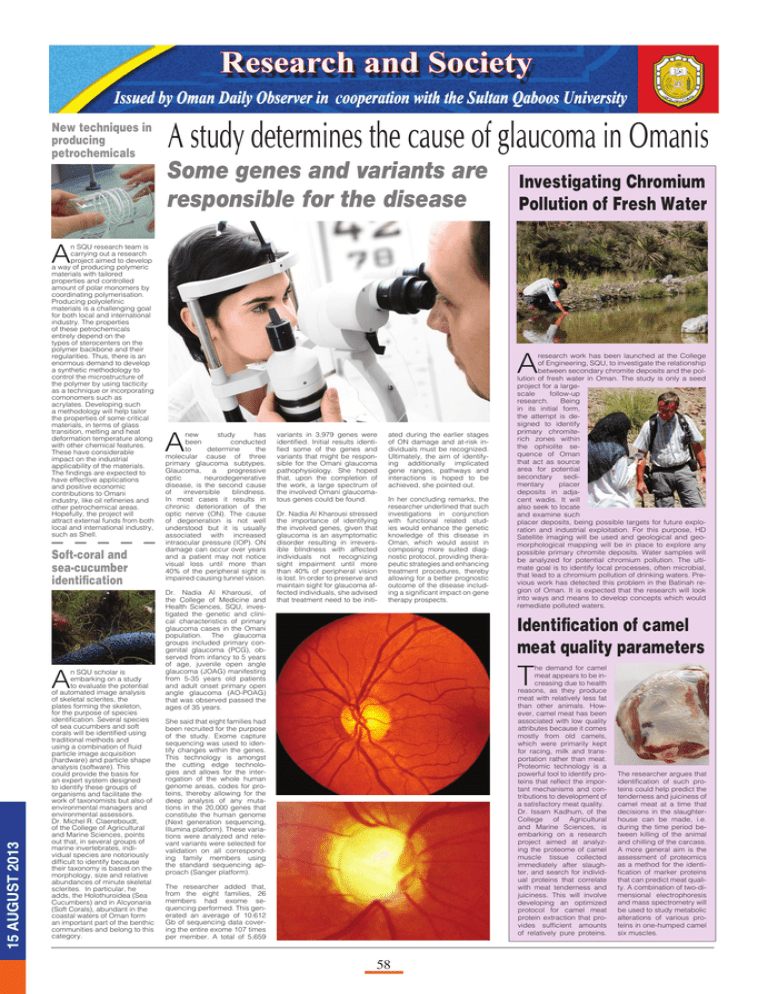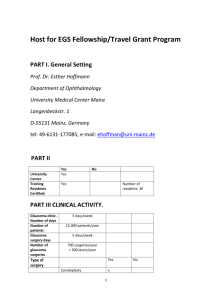A
advertisement

New techniques in producing petrochemicals A study determines the cause of glaucoma in Omanis Some genes and variants are responsible for the disease Investigating Chromium Pollution of Fresh Water A n SQU research team is carrying out a research project aimed to develop a way of producing polymeric materials with tailored properties and controlled amount of polar monomers by coordinating polymerisation. Producing polyolefinic materials is a challenging goal for both local and international industry. The properties of these petrochemicals entirely depend on the types of sterocenters on the polymer backbone and their regularities. Thus, there is an enormous demand to develop a synthetic methodology to control the microstructure of the polymer by using tacticity as a technique or incorporating comonomers such as acrylates. Developing such a methodology will help tailor the properties of some critical materials, in terms of glass transition, melting and heat deformation temperature along with other chemical features. These have considerable impact on the industrial applicability of the materials. The findings are expected to have effective applications and positive economic contributions to Omani industry, like oil refineries and other petrochemical areas. Hopefully, the project will attract external funds from both local and international industry, such as Shell. Soft-coral and sea-cucumber identification 15 AUGUST 2013 A n SQU scholar is embarking on a study to evaluate the potential of automated image analysis of skeletal sclerites, the plates forming the skeleton, for the purpose of species identification. Several species of sea cucumbers and soft corals will be identified using traditional methods and using a combination of fluid particle image acquisition (hardware) and particle shape analysis (software). This could provide the basis for an expert system designed to identify these groups of organisms and facilitate the work of taxonomists but also of environmental managers and environmental assessors. Dr. Michel R. Claereboudt, of the College of Agricultural and Marine Sciences, points out that, in several groups of marine invertebrates, individual species are notoriously difficult to identify because their taxonomy is based on the morphology, size and relative abundances of minute skeletal sclerites. In particular, he adds, the Holothuroidea (Sea Cucumbers) and in Alcyonaria (Soft Corals), abundant in the coastal waters of Oman form an important part of the benthic communities and belong to this category. A A new study has been conducted to determine the molecular cause of three primary glaucoma subtypes. Glaucoma, a progressive optic neurodegenerative disease, is the second cause of irreversible blindness. In most cases it results in chronic deterioration of the optic nerve (ON). The cause of degeneration is not well understood but it is usually associated with increased intraocular pressure (IOP). ON damage can occur over years and a patient may not notice visual loss until more than 40% of the peripheral sight is impaired causing tunnel vision. Dr. Nadia Al Kharousi, of the College of Medicine and Health Sciences, SQU, investigated the genetic and clinical characteristics of primary glaucoma cases in the Omani population. The glaucoma groups included primary congenital glaucoma (PCG), observed from infancy to 5 years of age, juvenile open angle glaucoma (JOAG) manifesting from 5-35 years old patients and adult onset primary open angle glaucoma (AO-POAG) that was observed passed the ages of 35 years. variants in 3,979 genes were identified. Initial results identified some of the genes and variants that might be responsible for the Omani glaucoma pathophysiology. She hoped that, upon the completion of the work, a large spectrum of the involved Omani glaucomatous genes could be found. Dr. Nadia Al Kharousi stressed the importance of identifying the involved genes, given that glaucoma is an asymptomatic disorder resulting in irreversible blindness with affected individuals not recognizing sight impairment until more than 40% of peripheral vision is lost. In order to preserve and maintain sight for glaucoma affected individuals, she advised that treatment need to be initi- ated during the earlier stages of ON damage and at-risk individuals must be recognized. Ultimately, the aim of identifying additionally implicated gene ranges, pathways and interactions is hoped to be achieved, she pointed out. In her concluding remarks, the researcher underlined that such investigations in conjunction with functional related studies would enhance the genetic knowledge of this disease in Oman, which would assist in composing more suited diagnostic protocol, providing therapeutic strategies and enhancing treatment procedures, thereby allowing for a better prognostic outcome of the disease including a significant impact on gene therapy prospects. research work has been launched at the College of Engineering, SQU, to investigate the relationship between secondary chromite deposits and the pollution of fresh water in Oman. The study is only a seed project for a largescale follow-up research. Being in its initial form, the attempt is designed to identify primary chromiterich zones within the ophiolite sequence of Oman that act as source area for potential secondary sedimentary placer deposits in adjacent wadis. It will also seek to locate and examine such placer deposits, being possible targets for future exploration and industrial exploitation. For this purpose, HD Satellite imaging will be used and geological and geomorphological mapping will be in place to explore any possible primary chromite deposits. Water samples will be analyzed for potential chromium pollution. The ultimate goal is to identify local processes, often microbial, that lead to a chromium pollution of drinking waters. Previous work has detected this problem in the Batinah region of Oman. It is expected that the research will look into ways and means to develop concepts which would remediate polluted waters. Identification of camel meat quality parameters T he demand for camel meat appears to be increasing due to health reasons, as they produce meat with relatively less fat than other animals. However, camel meat has been associated with low quality attributes because it comes mostly from old camels, which were primarily kept for racing, milk and transportation rather than meat. Proteomic technology is a powerful tool to identify proteins that reflect the important mechanisms and contributions to development of a satisfactory meat quality. Dr. Issam Kadhum, of the College of Agricultural and Marine Sciences, is embarking on a research project aimed at analyzing the proteome of camel muscle tissue collected immediately after slaughter, and search for individual proteins that correlate with meat tenderness and juiciness. This will involve developing an optimized protocol for camel meat protein extraction that provides sufficient amounts of relatively pure proteins. She said that eight families had been recruited for the purpose of the study. Exome capture sequencing was used to identify changes within the genes. This technology is amongst the cutting edge technologies and allows for the interrogation of the whole human genome areas, codes for proteins, thereby allowing for the deep analysis of any mutations in the 20,000 genes that constitute the human genome (Next generation sequencing, Illumina platform). These variations were analyzed and relevant variants were selected for validation on all corresponding family members using the standard sequencing approach (Sanger platform). The researcher added that, from the eight families, 26 members had exome sequencing performed. This generated an average of 10.612 Gb of sequencing data covering the entire exome 107 times per member. A total of 5,659 58 The researcher argues that identification of such proteins could help predict the tenderness and juiciness of camel meat at a time that decisions in the slaughterhouse can be made, i.e. during the time period between killing of the animal and chilling of the carcass. A more general aim is the assessment of proteomics as a method for the identification of marker proteins that can predict meat quality. A combination of two-dimensional electrophoresis and mass spectrometry will be used to study metabolic alterations of various proteins in one-humped camel six muscles.




